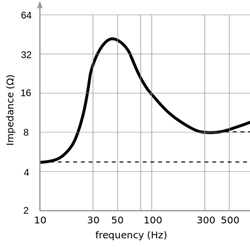
Additionally, very high input impedances allow a source signal to be split several ways without loading down the source or incurring too much line loss.
For example, a Telefunken M80 vocal mic has an output Z of 300 ohms, and the preamps on a Midas PRO2 console are rated at 10 kohms (kilo ohms). The mic’s signal could be split three ways, to front of house, monitors and broadcast, with a signal drop of less than 1 dB.
Commercial distributed loudspeaker installations make good use of both of these benefits. These “constant voltage” systems often consist of dozens of loudspeakers and thousands of feet of cable. Cables losses are reduced by raising the amplifier output voltage to 70 volts or 100 volts, which can deliver the same power at a lower current, enabling long runs of thinner cable.
The loudspeakers are transformer-loaded, presenting a high impedance to the network. In this way, additional loudspeakers can be added without significantly affecting the loading on the amplifier. For an analogy, think of running a pH test on a swimming pool. You only need to sample a small cup of water to determine the pH level of the entire pool, and you could take many cupfuls of water without appreciably affecting the water level in the pool. In the same way, these loudspeakers can gently “sip” the signal without disrupting the whole system.
Friends In Low Places
The standard passive loudspeakers that we’re all familiar with are known collectively as “low impedance” loudspeakers, to distinguish them from the transformer-loaded models used in 70-volt and 100-volt systems. With impedances in the neighborhood of 8 ohms, they present a comparatively high Z to power amplifiers, which have output impedances around .01 ohm. At ratios like this, it’s easy to see why the loudspeaker’s varying impedance over frequency doesn’t tend to provoke too much of a change in frequency response.
A notable exception are the tube amplifiers typically preferred by audiophiles. Their output Zs are much, much higher – between 1 and 3 ohms – approaching the 1:1 ratio ideal for impedance-matched power sharing. At these loads, there’s a lot more interaction between the amp and the load, so that variance in Z can make a big difference. What some audio reviewers refer to as the “personality” or “character” of a tube amp is actually the amp struggling, and failing, to maintain linearity. This is not an ideal situation for us in professional audio.
That said, the same interaction is the driving force behind boutique mic preamps with variable Z. Lowering the preamp’s input Z loads down the mic, which can create nonlinearities that emulate the sound of a vintage mic pre. For this reason, we use hi-Z Dis for devices like electric guitar pickups and piezo pickups.
Since these sources have a high Z, they require a proportionally higher impedance load to ensure linearity. The typical “squawky” mid-heavy tone of piezo pickups is a symptom of insufficient load impedance, which can be rectified with a specialty hi-Z DI such as Radial’s PZ-DI. The bottom line is that the load impedance should be significantly higher than the source impedance in order to ensure that the devices perform as designed.
Impedance In Series
You don’t see this all that often these days, because when devices are in series, a failure anywhere takes down the whole signal chain, like a string of Christmas lights with one bad lamp. Occasionally you might come across an old set of column loudspeakers with drivers wired in series.
In series, impedance adds linearity, so six 1-ohm drivers would present a load of 6 ohms to the amp. Besides the lack of resiliency in case of a failure, placing many drivers in series is inopportune for system tuning, because per-driver delay, equalization, or gain adjustments become impossible.
